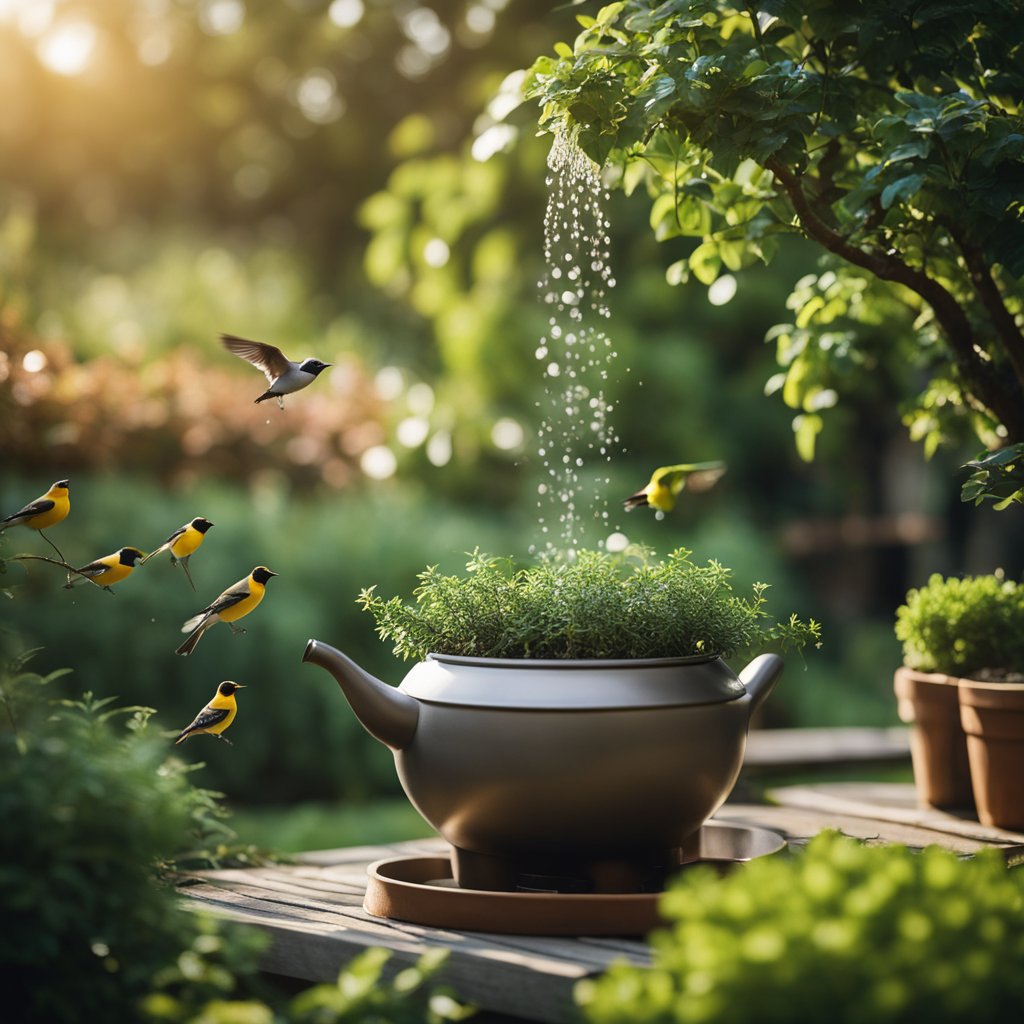Providing a fresh water source in your yard or garden is one of the simplest and most impactful things you can do to help local birds. Access to clean water is essential for birds to stay hydrated and thrive. However, pollution and destruction of natural water sources mean safe water is increasingly scarce. Installing thoughtfully designed birdbaths, drippers, misters, and small ponds provides vital hydration stations for birds in need.
Water is especially critical in summer’s heat and during nesting season when activity levels surge. In dry climates or winter, when liquid water is limited, an open water feature can be a lifesaver to birds. Beyond drinking, birds use water sources for bathing, preening feathers, cooling off, and deterring parasites. Ensuring a year-round water supply will attract more species diversity to your yard.
This article explores how to best provide water for birds based on their seasonal needs. You’ll learn about different water feature options, from simple ground birdbaths to elaborate cascading fountains. Proper placement, cleaning routines, and safety measures are also detailed. By incorporating quality bird watering stations, you can directly aid local wildlife while enjoying the beauty and activity they bring to your outdoor space. Let’s get started exploring how to set up the essential gift of water for your wild feathered visitors.
Importance of Water for Birds
Providing a fresh clean water source is one of the most impactful ways to help backyard birds. Water is essential for birds’ hydration, temperature regulation, preening feathers, insect control, and more. Since natural water sources are declining, artificially supplying water improves birds’ health and supports populations. Strategically placed bird baths, misters, drippers, and fountains offer vital hydration.
Overview of Methods to Provide Water
There are many creative options for bringing water into your yard for birds beyond typical bird baths. You can install misters, drippers, moving fountains, recycled bottle hangers, and small ponds or pools. Providing multiple water sources in varying locations enhances accessibility. Establish proper daily cleaning routines to keep refreshed. Learn birds’ seasonal water needs to best support them throughout the year.
Understanding Birds’ Water Needs
Daily Water Intake for Birds
Birds require frequent hydration due to their high metabolism. The exact amount varies by species and environment, but most backyard birds drink about twice their body weight daily. For example, a half-ounce chickadee needs at least an ounce of fresh water every day. Birds’ intake increases during hot weather, breeding times, and growth spurts. Ensuring adequate clean water prevents dehydration.
Seasonal Variations in Water Requirements
Birds’ hydration needs fluctuate based on season, temperature, and activity level. In winter, birds consume less but still require open liquid water sources since food contains little moisture. In summer, water needs surge to counteract heat and additional demands of nesting and rearing young. During migratory periods, establishing pit stops with water helps migrating birds fuel up. Cater seasonal water offerings to birds’ needs.
Types of Water Sources for Birds
Natural Water Sources
In the wild, birds tap into surface water from lakes, streams, puddles and seasonal pools. Backyards may naturally feature ponds, creeks, rain catchers, and damp ground. However, pollution and destruction of natural wetlands make clean natural water scarce. But you can mimic natural options.
Artificial Water Sources
With natural sources declining, artificial water provision is essential for aiding backyard birds. Here are some popular options:
Bird Baths
Bird baths range from simple ground basins to cascading baths and squirting fountains. Select a size and design that suits your space and budget. Include shallow areas, textured surfaces for grip, and sloping sides. Place baths at ground level or on elevated stands.
This resource from Cornell discusses bird bath selection
Misters and Drippers
Misters and drippers provide consistent moisture. Birdbath misters attach to standard baths. Drippers made from suspended bottles simply leak water. Moving water deters mosquitoes too. Their constant flow ensures freshness.
Fountains and Waterfalls
More elaborate bird bath fountains and mini waterfalls entice many species. Their sights and sounds beckon birds. The cascading and recirculating water stays oxygenated. Fountains deter mosquitoes. But position fountains to prevent unwanted splashing.
Bird Bath Selection and Placement
Choosing the Right Bird Bath
Consider your budget, yard space and landscaping, and target bird species when selecting a bird bath. Choose durable, weather resistant materials like concrete, stone, ceramic or heavy duty plastic. Include varying depths from 1”-3” with textured bottoms. Built-in drains and reservoirs aid cleaning. Fit bath style to your yard.
The National Institute of Building Sciences offers bird bath guidance.
Optimal Placement for Safety and Attraction
How you place your birdbath is key. Set it near protective shrubs or trees within 5-10 feet for quick escape from predators and relief from heat. A clear 360 view lets birds watch for danger. Nearby perches like rocks or logs also aid use. Keep it far from foreign structures and feeding areas to prevent contamination. Position for easy cleaning access too.
Maintaining Clean Water Sources
Daily Maintenance Tips
Prevent disease by freshening water daily, or more in summer. Scrub baths with a vinegar/water solution, empty water, and refill with fresh water to kill bacteria. Remove droppings, dead insects, and debris with a cover skimmer or mesh strainer. Discourage ants and bees by sprinkling cinnamon powder around bath edges.
Preventing Algae and Bacteria Growth
To control algae and bacteria buildup, clean baths thoroughly weekly too. Deep clean with mild bleach solution using dish soap if green biofilm develops. Allow to dry fully. Consider copper baths which limit algae growth. Small fountain pumps or bath circulators also inhibit bacteria.
Enhancing Your Garden for Birds
A. Adding Plants That Attract Birds
Incorporate berry bushes, nectar flowers, fruit and seed-bearing plants to provide natural food and shelter sources near water stations. Favored trees like dogwoods or oaks give shade and perches too. Select native species specifically suited to birds in your region. The Audubon Society’s native plants database is a great resource.
Creating Shelter Near Water Sources
Make birds feel safer and more at home by adding sheltering bushes, hedges, trellises, long grasses and rock piles near baths. These allow a hidden approach with quick escape routes. Establish overhanging branches above the bath for added coverage. Buttonbush, elderberry, and willow bushes work well. Place multiple shelters in different directions.
Protecting Birds from Predators
Identifying Potential Predators
Assess what predatory animals frequent your area that may endanger visiting birds. Common bird predators include outdoor cats, snakes, hawks, raccoons, and opossums. Even somewhat harmless bullfrogs and turtles will snatch tiny bird toes in water! Being aware of threats lets you better safeguard spots.
Measures to Safeguard Watering Spots
There are many strategies to secure watering zones from predators. Install plastic owl or hawk decoys to scare aerial predators. Use scare tape on plants bordering baths. Poke chopsticks into bath rims to prevent larger animals drinking. Place thorny perimeter plants to deter animals. Set baths in open, well-lit spots.
Engaging the Community in Bird Conservation
Educational Programs on Bird Hydration
Get others involved in providing water for birds through outreach at schools, nature centers, youth groups, social media sites, and community events. Share quick tips like recycling takeout containers as bird baths or mouth-watering fruits on skewers above baths. Highlight fascinating facts about how birds drink and bathe. Promote activities like bath building workshops or “clean the birdbath day”.
Community Projects to Provide Water for Birds
Organize groups to install public bird baths and fountains at parks, wildlife refuges, gardens and other community spaces. Scout ideal locations in peaceful sites with protective cover. Develop plans accounting for budget, supplies, accessibility, safety, and maintenance roles. Fundraise if needed. Engage volunteers of all ages to help build and decorate. Anything promoting bird bath access expands critical water sources.
The Impact of Water Provision on Bird Populations
Providing supplemental clean water sources helps counter the loss of natural wetlands critical to birds. On hot summer days, baths can be literal lifesavers for dehydrated birds. Year-round access aids survival and breeding. Reports show properties with quality birdbaths attract up to 50% more species diversity. Promoting community installations expands resources regionally, benefitting both residents and birds. Even small personal baths make a difference – join in assisting birds’ hydration needs!
People Also Read:
Conclusion
Providing fresh clean water is one of the most important offerings we can make to help local birds thrive. The variety of birdbaths, drippers, misters and fountains available means you can find an aesthetically pleasing option tailored to your space and budget. Strategically place water sources with birds’ safety and accessibility in mind. Establish a rigorous cleaning routine to prevent disease transmission. Educate others in your community on the importance of birdbaths for conservation. With some simple planning, you can establish a vital oasis for hydrating birds in your area. The sight of colorful songbirds splashing in your water feature will be reward enough for your efforts.
Frequently Asked questions
Q: How often should I change the water in a bird bath?
A: For optimal cleanliness, dump and refill birdbaths with fresh water daily. This prevents dangerous bacteria and mosquitoes from accumulating. During hot weather, refresh water multiple times a day.
Q: What are some good plants to have near a bird bath?
A: Some great plant choices are berry bushes like blackberries or blueberries, nectar sources like trumpet vines or petunias, and protective cover plants like ferns or hostas. Select a variety of native plants that will attract birds.
Q: What homemade birdbath ideas work well?
A: You can repurpose all kinds of items as creative birdbaths like garbage can lids, boot trays, aluminum roasting pans, recycled takeout containers, and old cooking pots. The key is including shallow, textured areas and keeping them clean.
Q: Should birdbaths be elevated or on the ground?
A: Ground-level birdbaths are more accessible but raise predation risks. Elevated baths about 3-5 feet up on stands or posts are safer but may deter some species. Ideally provide options at varying heights to suit different birds.
Q: How can I stop mosquitoes in my birdbath?
A: Frequent water changes and scrubbing prevent mosquito larvae. Add a fountain pump for moving water. Try sinking ping pong balls to impede surface access. Lastly, use mosquito dunks – these contain natural bacteria that only kill mosquito larvae.

